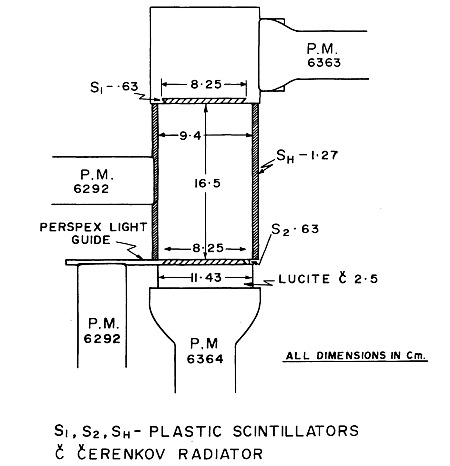Purpose of the flight and payload description
The objective of the flight was to make measurements of the vertical intensities of protons and helium nuclei in the stratosphere over Hyderabad, India during the International Quiet Sun year in April 1965. At left we can see a basic scheme of the instrument used for this measurements aproton-alpha telescope. It consisted of two thin plastic scintillators S1 and S2, and a lucite Cerenkov radiator C. S1 and S2 (each 6.3 mm thick) were viewed by diffuse reflection and through a Perspex light guide respectively as shown in the scheme. C was blackened at the top so as to eliminate upward moving splash albedo. The counter telescope was protected against side showers and 'out-of-geometry' particles by surrounding S1 and S2 with a cylindrical plastic scintillator SH. S2 limited the sensitive area of C so that the full cone of Cerenkov radiation produced by the incident particle was directly seen by the photomultiplier. Thereby edge effects in the Cerenkov radiator were reduced to a minimum.
Events were selected by a triple coincidence in the three detectors: S1, S2 and C. To reduce the total number of events recorded, so as to get a clear photographic record of the pulses, the electronic logic used was such that all events in which the pulse from S1 was less than 1.6 times the most probable pulse due to a singly charged particle, pulse heights in S1, S2 and C were recorded once for every four such events. However, all events in which S1 had a pulse greater than 1.6 times were recorded without any scaling and full pulse height information for all helium-like events was obtained. Since the counting rate due to 'singly charged' events was about 30 times that due to helium nuclei at flight altitude, the scaling didn't introduced any appreciable error in deducing the flux of singly charged particles from the observed pulse heights for the scaled-down events. Pulse heights in S1, S2 and C and the occurrence of side shower events were displayed on a double beam cathode ray tube and were photographed on a continuously moving film.
Details of the balloon flight
Balloon launched on: 4/28/1965
Launch site: Osmania University Campus, Hyderabad, India
Balloon launched by: Tata Institute of Fundamental Research (TIFR)
Balloon manufacturer/size/composition: Zero Pressure Balloon
End of flight (L for landing time, W for last contact, otherwise termination time): 4/28/1962
Balloon flight duration (F: time at float only, otherwise total flight time in d:days / h:hours or m:minutes - ): F 3 h 26 m
External references
- Flux of primary protons and helium nuclei and East-West and North-South asymmetries near the geomagnetic equator Proceedings of the 9th International Cosmic Ray Conference, Vol. 1, p.457
- Flux of Primary Protons and Helium Nuclei Near the Geomagnetic Equator Proceedings of the ninth symposium on Cosmic Rays, Elementary Particle Physics and Astrophysics; Bombay December 13-17, 1965
15909If you consider this website interesting or useful, you can help me to keep it up and running with a small donation to cover the operational costs. Just the equivalent of the price of a cup of coffee helps a lot.


